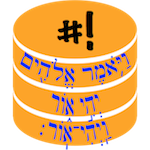-
Notifications
You must be signed in to change notification settings - Fork 3
Home
This will involve a bit of downtime while we move the data of SHEBANQ from one database location to another. It might also take some time before your browser follows the path to the new SHEBANQ.
Below you can do a quick start with SHEBANQ. In case you want to know about the who, what, and how, follow these links:
We rely on your curiosity and urge to click on everything clickable and non-clickable to see what happens.
In SHEBANQ you can ...
- browse the Hebrew Bible
- look up words
- make queries based on linguistic information
- add notes.
- share and publish your queries and notes and read those of others
- visualize where specific words occur and where your query results are.
- export result lists as CSV files.
- See the sidebar for all help topics.
Happy shebanqing
You can just read the text In the margin you find related queries, and you can follow them.
You can also start with a query, such as shibboleth (1 result) or a word such as the definite article (more than 30,000 occurrences).
Do not forget to use the clickable chart, which shows you how your results are distributed over the text as a whole.
You can even download the results as a csv file and use your spreadsheet program to make a nicer chart.
Or find other shared queries that interest you.
You switch back and forth from browsing passages to inspecting relevant queries by clicking on queries in the margin and verse labels in the text material.
Another way of navigating is by means of the cross-references between similar passages, which are shown as the note set crossref.
The data that underlies the text of a verse can be viewed by clicking on the verse number.
You can contribute queries and notes yourself, after logging in.
When writing a query, by filling in your institution and your project you provide other users with a bit of context.
Precise, concise documentation is at your finger tips
Once you are logged in, you can enter manual notes right away. Go to notes view.
You can share publish your queries and notes, so that they show up in the margin of the chapters containing their results.
In this way they become a valuable resource for fellow Hebrew readers.
See for example this set of real-life, yet tutorial style queries by Oliver Glanz, Reinoud Oosting, and Martijn Naaijer.
If you want to cite your shared query or note set in a publication, you can also publish it.
On publishing, your query and its results on a particular version of the database will be frozen, so that others will see exactly the same results later on.
When newer versions of the database arrive in SHEBANQ, you can run the same query on the new data. You can modify that version of your query and publish it separately from earlier versions.
You can generate notes sets by means of software, possibly aided by text-fabric and bulk upload them to SHEBANQ.
See how it is done in parallels and valence.
Have a look at Martijn Naaijers course materials if you are interested in R-analysis of the Hebrew data.
At this stage, you might want to consult the references to the ETCBC method.
![]() SHEBANQ is free software.
SHEBANQ is free software.
The tools used to run the SHEBANQ website and to do the data preprocessing, and all the recipes are available online.
You can reproduce SHEBANQ and make it better, or write totally different applications for processing the ETCBC data.
We have put the software in this repository in the public domain under the UNLICENSE. Note that the UNLICENSE is not the absence of a license. It is a license that tries hard to convince you and everybody else that you can do with this software what you want without any requirement.

Moreover, the data on which all is based, is Open Access and can be obtained from GitHub or DANS or Zenodo. The license to use the data is such that nothing stands in your way, as long as you stay non-commercial.



 BHSA Feature docs
BHSA Feature docs